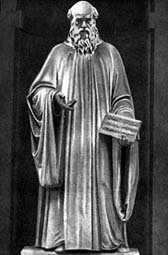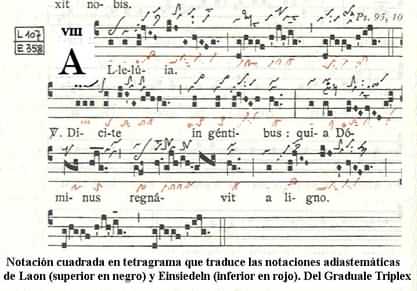
| LESSONS
ON GREGORIAN CHANT |
2. GREGORIAN NOTATION
In the 11th century the repertoire of chants in the Church covered already the feast of each day and of each event of the Liturgy. The sacred texts had its own characteristic and variety of forms: Introits, Antiphons, Graduals, Hallelujahs, Offertories, Communions, Sequences, etc. to which it should be added those parts of the Liturgy called "Ordinary": Kyries, Glorias, Creeds, etc. All this had to be entrusted to the memory of singers who did not have any musical help, except some marks on the text indicating simply when the melody rose or descended just as is shown in the above manuscript. Of course, the conservation of the chants entrusted only to the good memory did that they were in danger to disappear. Initially the musical notation served like an aid-to-the-memory for whom already had an idea about how should sound. It not was intended that notation was "scientifically" precise. The concept that a melody can be sung reading correctly the score (without the need of having listened previously) is something relatively very new. The oldest examples of musical notation in Western Europe were a kind of writings more as annotations for the texts that were sung. On the other side, the purpose of notation was more that of indicating the expressive character to stand out the subtleties of the vocal expression than that of indicating the height of the melodic notes (at present a great deal of investigation is going on by musicologists specialized in Medieval music) .
He invented the stave of four lines; of them, a yellow line would be UT (subsequently became DO —C— ) and a red line would indicate FA (F); this would give origin later to the notion of the clefs.
The height of the sounds is indicated by the location of the notes in a stave of four lines, with the possibility to use lower and upper additional lines.
The clefs are of DO (C) and of FA (F) which can be in the second, third or fourth line.
The possible extension is:
Simple notes Here is presented, in its order, the primitive notation, the present Gregorian notation and its equivalent one in modern notation.
Virga=Stick; Punctum quadratum=square point, Punctum inclinatum=inclined point. Simple neumes
Pes, Podatus of the Latin foot; Torculus, of the latin torquere=to twist, by its broken form; Porrectus, of the Latin porrigere=to extend, by the extended form of its lines; Climacus, of climax=stair; Scandicus, of scandere=to rise; Salicus of salire=to jump.
Special neumes
Decorative neumes
The signs of pause, originated by the structure of the text, are:
5. OTHER SIGNS Custos: The custos is a sign that goes at the end of each stave. This is not sung, instead it serves as a visual cue to the pitch of the first note on the next line. Also it is used when inside a same musical piece there is a change of clef.
B Flat:
In Gregorian Chant the only accidental is B flat (rarely) which is indicated by a B Flat sign. The Flat affects not only the note B that carries it but to the others that appear later and it is canceled by the change of word, by any dividing line or by the natural sign. The B Flat at the foot of the clef remains during all the piece and is canceled only by the natural sign. "Euouae"
See MARTINEZ SOQUES, Fernando. Método de Canto Gregoriano, Capítulos VI y VII. Ed. Pedagógica. Barcelona, 1943. See an interesting
page in which the evolution in the systems of the Chant Notation
is shown. http://users.pandora.be/greetendirk/gregoriaans/EN/ENmu_05.htm
|
|||||||||||||||||||||||||||||
![]()
Theory
and Technic | Canticum
Novum | Didactic
Concerts |
Links
History | Characteristics
| Notation | Modes
| Rhythm | Chironomy
| The psalmody |
| Latin pronuntiation |
Translations & scores|
Bogotá/Colombia - 2002






































